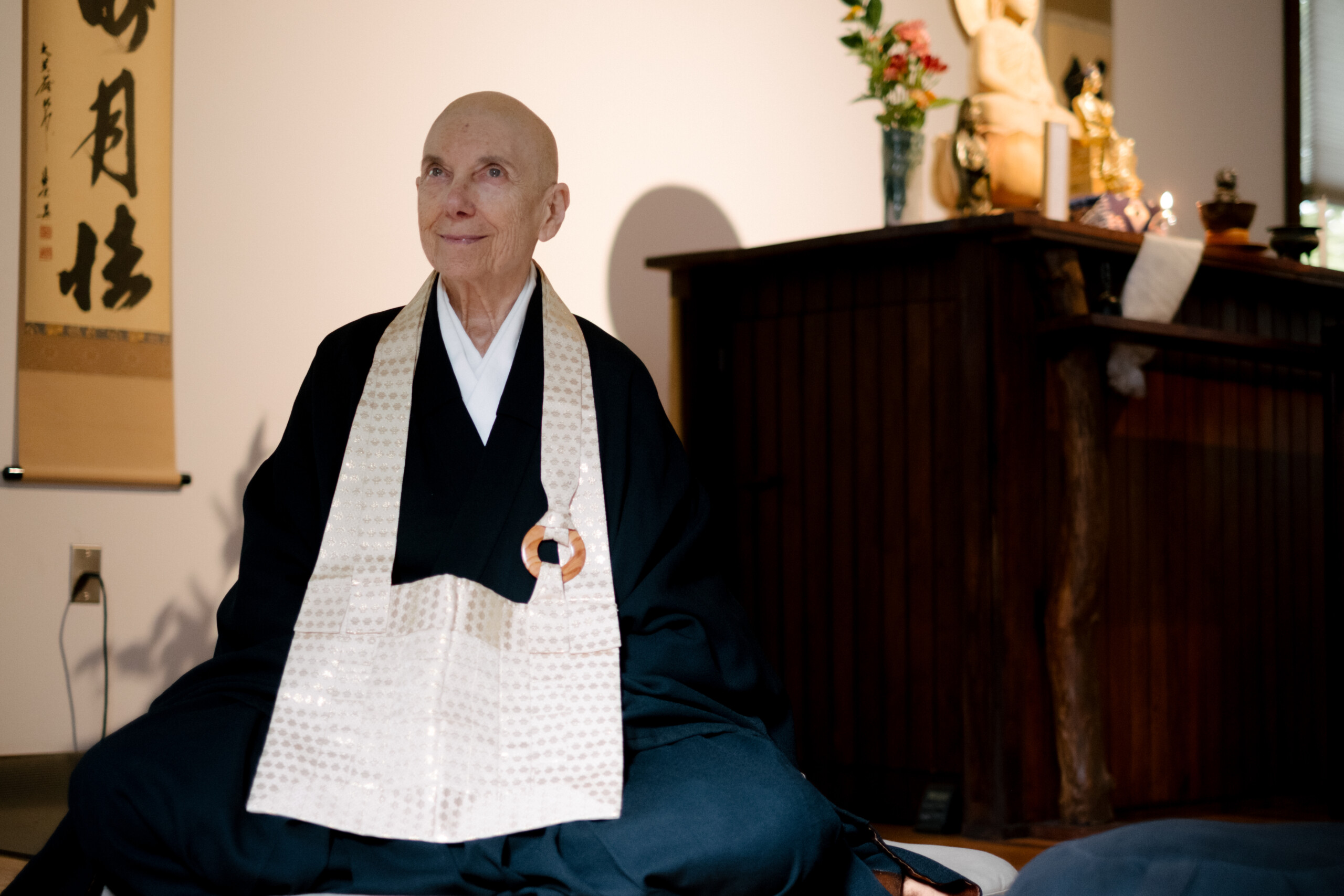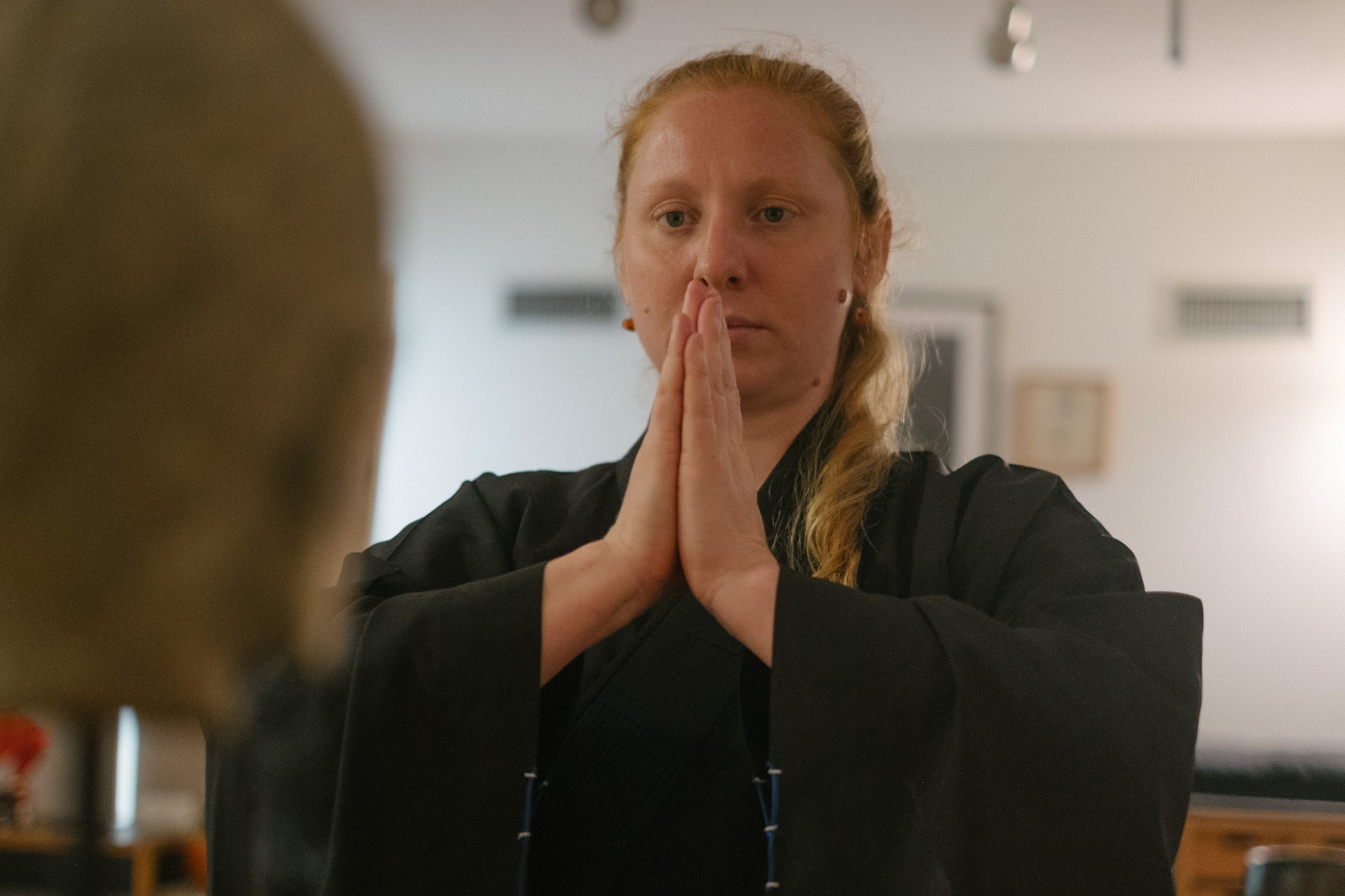Biography
Shinge Roko Sherry Chayat Roshi is abbot of the Zen Studies Society’s mountain monastery, Dai Bosatsu Zendo Kongo-ji, and New York City temple, New York Zendo Shobo-ji, and is also abbot of the Zen Center of Syracuse Hoen-ji in Syracuse, NY. She began formal Zen practice at the Zen Studies Society in 1967. She served as co-director of the first residential community at Dai Bosatsu Zendo from 1974 until 1976, when she moved to Syracuse and began leading the Zen Center there. She received lay ordination from Maurine Stuart Roshi in 1985, and full ordination from Eido Shimano Roshi in 1991. She was installed as abbot of the Zen Center of Syracuse in 1996; received Dharma Transmission from Eido Roshi in 1998; and in 2008 was authorized as a roshi, or Zen Master, and given the name Shinge, meaning “heart-mind flowering.”
In addition to her work as a Zen teacher, Shinge Roshi is an award-winning writer and editor. She compiled and edited Eloquent Silence: Nyogen Senzaki’s Gateless Gate and Other Previously Unpublished Teachings and Letters (Wisdom Publications); Endless Vow: The Zen Path of Soen Nakagawa, with Eido Shimano Roshi and Kazuaki Tanahashi (Shambhala); and Subtle Sound: The Zen Teachings of Maurine Stuart (Shambhala). She is also the author of Circle: The Zen Brushwork of Kazuaki Tanahashi (Amsterdam: Samsara Uitgeverij) and Life Lessons: The Art of Jerome Witkin (Syracuse University Press), and her articles and reviews have appeared in Buddhadharma, Tricycle, Tikkun, ARTNews, Sculpture Magazine and American Ceramics, among others. Her weekly art column in Syracuse Newspapers’ Sunday Stars Magazine ran for twenty years. She is a graduate of Vassar College.
Background
Shinge, formerly known as Shinji, shares her transformative journey at the Zen Center of Syracuse. Initially drawn to the practice intuitively, she recounts sitting under a tree, embracing the present moment, and experiencing a profound shift in her perspective. Her connection with Zen and the teachings of the Buddha resonates deeply, providing a context for her spiritual experiences. Despite being immersed in the art world as a painter and critic, Shinge yearns for a more formal engagement with practice, leading her to the Zen Studies Society in New York City and her first teacher. Emphasizing the significance of a formal connection with a teacher, she expresses the ineffable nature of the Dharma and the shared pursuit of understanding the mystery that Buddhism presents. Shinge, now Raquel Sherry, invites others to embrace the enigmatic nature of Buddhism rather than demystify it, fostering a sense of shared exploration and depth in the spiritual journey.
Buddhism in modern age
Shinge, a practitioner deeply rooted in Buddhist traditions, emphasizes the adaptability and flexibility inherent in Buddhism. Reflecting on the teachings of the Buddha, she highlights the importance of tailoring discussions to individuals, using diverse approaches depending on the audience, such as discussing parenting with a mother or delving into poetry with a poet. Despite her initial informal approach to practice, Shinge asserts her commitment to tradition, recognizing the value of the formal training she has undergone in Zen. She underscores the necessity of disciplined practice to tame the ever-active mind, describing the challenge of mastering focus and attention. Shinge elucidates the fundamental teachings of breath awareness and traditional methods for sharpening attention, ultimately aiming to cut through the delusions of the ego. She acknowledges the paradox of striving for realization until one reaches the understanding that there is no effort required in the awakening process. Shinge encapsulates the essence of Zen, where profound effort leads to the realization that, fundamentally, one is already whole and fine from the beginning.
Jewish Heritage
Shinge, hailing from a Jewish family background that had distanced itself from religious beliefs after the Holocaust, recounts her early questioning of rational humanism embraced by her secular humanist parents. Despite their attempt to confine knowledge within a circle of scientific and rational understanding, Shinge felt drawn to the limitless aspects outside that circle from a young age. As she reflects on her life journey, she reveals the intertwining of Judaism and Buddhism, acknowledging the profound influence of Jewish values, especially “tikkun olam” or repairing the world, on her compassionate engagement with the world, resonating with the Buddhist concept of the Bodhisattva Vow. In her later years, Shinge rediscovers and appreciates the richness of Jewish teachings, finding relevance in the ancient tradition she was born into. Despite her family’s lack of observance, she sees the connection between meditation’s silence and the Jewish concept of the “still small voice” that requires a contemplative state to hear the ineffable mystery that transcends the label of God. Shinge emphasizes the power of unifying both Buddhist and Jewish practices, recognizing the richness and depth they bring to her adult life.
Lineage
Shinge delves into her attraction to Tibetan Buddhism due to its esoteric qualities but ultimately finds a sense of belonging in the simplicity and clarity of the Zen tradition. Despite her respect for Tibetan teachers, she feels drawn to the clean and straightforward nature of Zen. Expressing the importance of surrender and commitment in spiritual practice, she reflects on the profound moment of meeting her Zen teacher and feeling a sense of home. She emphasizes the need for patience and the challenge of instant gratification in today’s society, cautioning seekers to invest themselves fully in one path rather than constantly seeking alternatives. Shinge underscores the significance of the teacher-student relationship, particularly the one-on-one meetings known as Dokusan, where practitioners bring their struggles with koans. She highlights the transformative nature of these encounters, describing the process of becoming friends with the koan and the breakthrough moments that fundamentally transform the practitioner. A good teacher, according to Shinge, guides, encourages, denies, and challenges the student in a dynamic relationship of struggle and growth.
Teacher Misconduct
Shinge reflects on the complexities of the teacher-student relationship, acknowledging the heights and depths of understanding that individuals can reach while still being plagued by their own karmic flaws. She shares her personal experience of facing accusations of sexual misconduct against her teacher, leading her to temporarily leave and seek guidance from Maureen Stewart, a female teacher. The stormy relationship with her stepfather had left Shinge in search of acceptance and approval, which she found in a different teaching approach under Maureen.
Upon Maureen’s passing, Shinge returned to her original teacher, recognizing the flaws but appreciating the depth of his teachings. However, as more revelations surfaced, she had to make the difficult decision to ask him to stop coming to the Zen Studies Society, where she was named the Abbot. Despite the challenges and difficult years, Shinge acknowledges the valuable lessons learned from this experience, emphasizing the need for caution in teacher-student relationships.
She reflects on the personal aspect that can lead teachers to fall into emotional entanglements with their students, cautioning against idolization and emphasizing the importance of maintaining boundaries even as the practice fosters a sense of oneness. Shinge recognizes the ongoing challenge of navigating these complexities and expresses the careful approach she now takes with her own students.
Teaching Evolution
Shinge emphasizes the regional nature of her teaching approach, highlighting the message that individuals are inherently okay as they are. She encourages self-discovery, urging students to question and experience for themselves rather than relying solely on her guidance. Shinge acknowledges the historical challenge in Buddhism where some individuals are willing to undergo rigorous training while others seek an easier path. In response to the desire for accessibility, she affirms that everyone is welcome to engage in the practice but underscores the importance of recognizing that the awakening is not something to obtain but rather to realize within oneself through dedicated effort and experience.
Sharing the dharma
Shinge reflects on the unique aspects of her teaching lineage, which has historically avoided self-promotion, a departure from the prevalent trend in American culture. Influenced by her teacher’s emphasis on self-demotion, Shinge finds the idea of gaining followers antithetical to the spirit of her tradition. Despite this, she recognizes the importance of making the teachings accessible and has adapted to contemporary methods by recording talks and utilizing social media platforms like YouTube through the Zen Studies Society.
Acknowledging her preference for traditional methods, Shinge expresses concern about the overwhelming influx of media in modern society. While recognizing the value of technology, she underscores the importance of unplugging through meditation. Despite the consumer-oriented mindset prevalent in society, Shinge emphasizes that the teaching is about recognizing one’s inherent perfection rather than seeking gains.
She invites those genuinely interested to find their teachings, emphasizing the commitment required for the grueling training of meditation. Shinge underscores the day-in, day-out nature of the practice, acknowledging that it may sometimes feel like drudgery but is crucial for true transformation. She concludes with the commitment expressed in the fourth of the four great vows, stating, “However endless the Buddha’s way is, I vow to follow it. You can join me or not.”
Gender
Shinge reflects on the gendered aspects of teaching and being seen, acknowledging the time it took to challenge the powerful hierarchy traditionally perceived through men’s eyes in the leadership role. Since taking over as Abbot, she has actively deconstructed this hierarchy, incorporating more democratic principles and witnessing the profound feminization of Buddhism in America with the rise of excellent women teachers.
She describes early meetings where women teachers, initially seen as revolutionary figures, gathered separately from men. These gatherings revealed shared feelings of insecurity and imposter syndrome among women teachers, questioning if they needed to be men to be perceived as genuine. Despite progress, Shinge notes an unexamined preference for the male voice among some students, even when conveying the same message as a female teacher.
Shinge explores the subtleties of gender and the extra effort she feels she has put in as a woman in a teaching role, striving for an impeccable presentation. As she approaches retirement at the age of 80, she plans to step back from administrative responsibilities while continuing to give talks at the monastery. Despite the challenges, she expresses deep love for her home temple, emphasizing the positive experience of working together with students from the beginning, free from the expectations of a male teacher.
She candidly admits that your questions have made her reflect on how she has been affected by internal assumptions about her role and the expectations placed upon her, echoing the experiences of women teachers in various fields who may grapple with underlying doubts about their capabilities.














































































